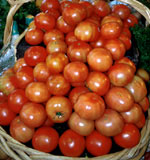
Genetically modified foods — you’ve heard about them, but you probably don’t know whether you’re eating them. They’re produced by splicing genes, those little segments of DNA that code for particular traits, from one plant or animal species and inserting them into another. Biotechnology companies are cooking up all sorts of techniques to engineer organisms in ways that they claim could make crops easier to grow, foods more nutritious, and production more efficient. But the jury is still out on the actual benefits these techniques will bring and there is growing concern about their impact on the environment and the security of our food supply.
Corn, potatoes, and cotton have been made to produce their own pesticides; squash and papaya can fight disease thanks to genes from a virus; and soybeans, corn, canola, and cotton have been rendered immune to certain weed-killing chemicals. Beyond crops, genetic engineering has been employed to make bacteria that produce bovine growth hormone to boost milk production in cows. Canadian scientists have given pigs a mouse gene to reduce the phosphorus in their manure in order to lessen the environmental impact of farm runoff. Salmon have been modified to use more of their own growth hormone to increase in size 400 to 600 percent faster than their natural counterparts.

Consumers should know the type of cotton they’re picking.
In 1999, just three years after the first large-scale harvest of genetically engineered crops, Consumers Union found transplanted genetic material cropping up in a wide variety of products from infant formula to nacho chips. We went to grocery stores and fast food restaurants and bought a number of foods made with corn or soybeans, the two crops most likely to be genetically engineered. Using a methodology powerful enough to detect engineered ingredients present at more than trace levels, we had the DNA of these foods analyzed. Even though none were labeled to indicate it, we found genetically engineered ingredients in the following products:
- Ovaltine Malt powdered beverage mix
- Bac-Os Bacon Flavor Bits
- Bravos Tortilla Chips Nacho Nacho!
- Old El Paso 12 Taco Shells
- Jiffy Corn Muffin Mix
- three powdered infant formulas — Enfamil ProSobee Soy Formula, Similac Isomil Soy Formula, and Nestle Carnation Alsoy
- several brands of soy burgers, including Boca Burger, Chef Max’s Favorite, Morningstar Farms Better ‘n Burgers, Green Giant Harvest Burgers (now called Morningstar Farms Harvest Burgers), and McDonald’s McVeggie Burgers, sold in select outlets in New York City
We don’t suggest that it is unsafe to eat these products. However, Consumers Union believes there are other reasons to be concerned about new hybrid products that nature could never produce on its own.

How do you label a cow?
For one thing, genetic engineering makes it possible to transfer allergenic properties of one food, like nuts, to another food product, like soybeans. In the mid-1990s soybeans that were modified with the gene of a Brazil nut were found to contain the allergen that makes some people allergic to the nuts. Fortunately, this problem was identified before the soy went to market. However, there is currently no mandatory screening process to guarantee that other, perhaps less anticipated, allergens are detected and kept off the market.
Another concern is that genetic engineering could inadvertently increase natural toxins or decrease nutrient levels in some foods. The exact role of different genes in a chromosome and the importance of the relationship of one gene to another are not well understood. The location on a chromosome where genetic material is inserted may affect the expression of other genes that control other functions, turning on a process that otherwise wouldn’t occur, or turning off a process critical to the health of the organism. This, coupled with the fact that modern genetic engineering techniques are fairly imprecise in terms of where the genes get placed within a chromosome, makes it difficult, and in many cases impossible, to fully predict the impact of inserting new genetic material.
A classic example of this unpredictability involved an attempt to suppress the color of tobacco and petunia flowers via the transfer of a synthetically created gene designed to turn off a host pigment gene. The expected outcome was that all the transformed plants would have the same color flowers. The actual result, however, was that the plants’ flowers varied not only in color but in color pattern, and some changed color or color pattern unexpectedly with the seasons. It’s not too far-fetched to imagine a similar scenario whereby an inserted gene could cause an increase in levels of a naturally occurring toxin generated by a plant, or a decrease in levels of nutrients.

‘Scuse me while I kiss this butterfly.
But even if foods aren’t engineered in ways that present health risks, there are emerging signs that genetically engineered crops may harm other species in the environment and decrease biodiversity, potentially creating a domino effect that could threaten our food supply and possibly harm our health in other ways. Laboratory studies by European scientists have found that pesticides made by genetically modified crops can be passed up the food chain and harm ladybugs and green lacewings, two beneficial predatory insects. Findings from Cornell University show that, in the laboratory, pollen from corn engineered to contain a natural pesticide from Bacillus thuringiensis (Bt) bacterium is toxic to the monarch butterfly. Because every grain of pollen produced by the engineered corn contains the Bt toxin, the risk to the monarch and other beneficial insects is dispersed into the environment as the pollen blows in the wind.
Other concerns relate to the possible transfer of virus-resistance genes from cultivated plants to their wild relatives, potentially creating weeds that are even more difficult to control. The transfer of antibiotic genes into wild bacteria could increase the growing problem of antibiotic-resistant microbes that would in turn pose an even greater threat to public health. What’s most troubling is the knowledge that once these genes have been released into the world, there’s no way to take them back.

A new meaning for Beefsteak tomatoes?
Genetic engineering also raises important ethical and cultural concerns for those who seek to avoid eating particular plants or animal food products for religious or other reasons. Vegetarians might want to avoid tomatoes engineered to resist cold with flounder genes, for example. The potential for inserting human genes into animals, as has been accomplished in laboratory experiments, raises even more serious ethical questions for many people.
So with all these problems, you might wonder what’s driving the rush to get genetically modified foods on the market. Biotech proponents say genetic engineering will reduce the need for weed-killing chemicals, improve yields, and help curb world hunger. But research has thus far failed to show that biotechnology is capable of achieving such lofty goals. Studies from 1996 through 1998 show different results for differen
t regions. In some cases yields increased, whereas in others they declined. The need for herbicide treatments also varied and in some cases where treatments for “target” organisms declined, greater amounts were needed to fight non-target pests.
With proper safeguards, genetic engineering could offer potential benefits to farmers and consumers, but the current safeguards simply aren’t sufficient. Consumers Union believes that genetically modified foods must be subject to mandatory federal human-safety reviews before they hit the market. Today such reviews are voluntary. The foods should also go through comprehensive environmental-safety reviews.
Finally, all genetically modified foods should be labeled so consumers can make informed choices about what they eat. Labeling is now required to tell consumers whether orange juice is fresh or from concentrate. It’s only logical to require food producers to disclose whether the genes in their products have been artificially manipulated.
More information on genetically modified foods can be found in the September 1999 issue of Consumer Reports.


